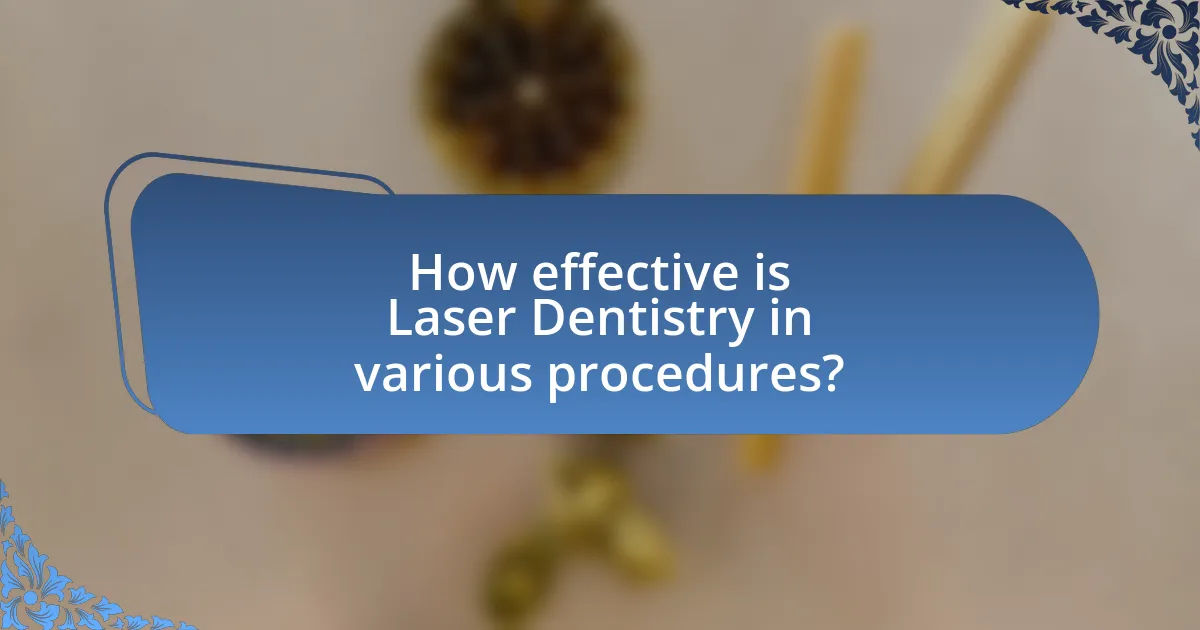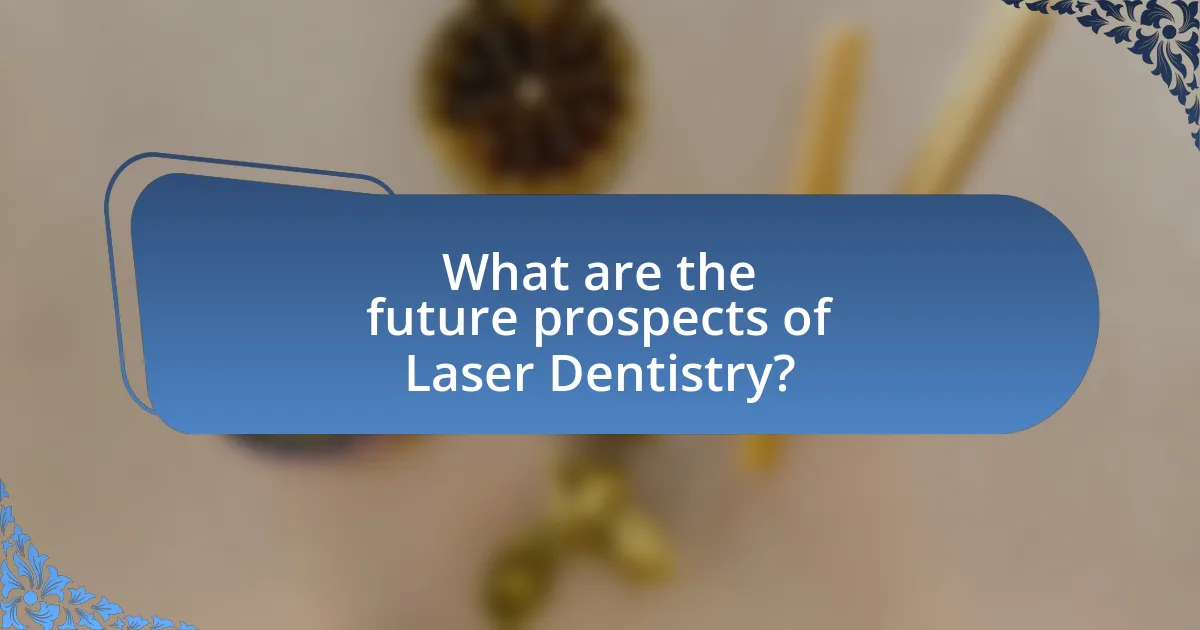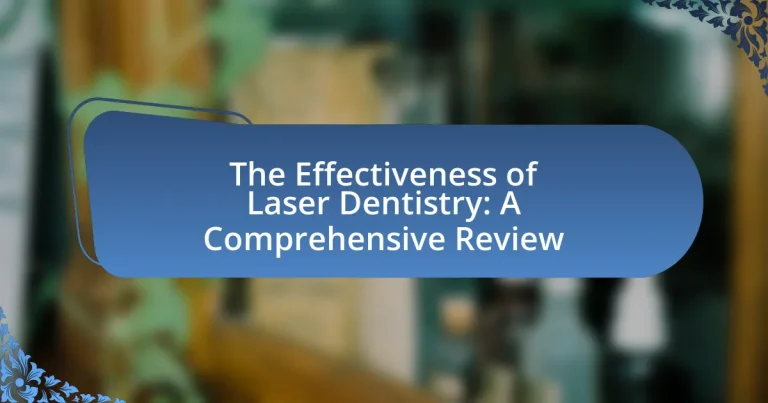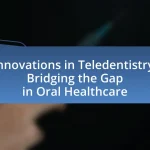Laser dentistry is a modern dental treatment that employs focused light beams to perform various procedures with enhanced precision and reduced invasiveness. This comprehensive review examines the effectiveness of laser dentistry in treating conditions such as gum disease, tooth decay, and cosmetic enhancements, highlighting its advantages over traditional methods, including less pain, minimized bleeding, and faster healing times. The article also discusses the types of lasers used, the specific procedures they can perform, and the potential limitations and risks associated with laser treatments. Additionally, it explores emerging trends and advancements in laser technology, emphasizing the growing integration of laser dentistry in clinical practice and its impact on patient outcomes.

What is Laser Dentistry?
Laser dentistry is a dental treatment that utilizes focused light beams to perform various dental procedures with precision. This technology allows for less invasive treatments, reduced discomfort, and quicker healing times compared to traditional methods. Studies have shown that laser dentistry can effectively treat conditions such as gum disease, tooth decay, and lesions, often resulting in less bleeding and a lower risk of infection. For instance, a review published in the Journal of Clinical Dentistry highlights that laser-assisted procedures can enhance patient comfort and improve clinical outcomes, demonstrating the effectiveness of this innovative approach in modern dentistry.
How does Laser Dentistry differ from traditional dentistry?
Laser dentistry differs from traditional dentistry primarily in its use of laser technology for procedures instead of conventional tools like drills and scalpels. This method allows for more precise treatment, often resulting in less pain, reduced bleeding, and quicker recovery times. Studies have shown that laser dentistry can minimize the need for anesthesia in many cases, enhancing patient comfort. Additionally, lasers can effectively target specific tissues, preserving surrounding healthy areas, which is a significant advantage over traditional methods that may cause more collateral damage.
What types of lasers are used in Laser Dentistry?
The types of lasers used in Laser Dentistry include diode lasers, carbon dioxide (CO2) lasers, and erbium lasers. Diode lasers are commonly utilized for soft tissue procedures, such as gum contouring and periodontal therapy, due to their efficiency in coagulating tissue. Carbon dioxide lasers are effective for both soft and hard tissue applications, including cavity preparation and oral surgery, as they can precisely cut and vaporize tissue. Erbium lasers, specifically erbium:YAG and erbium:glass, are primarily used for hard tissue procedures, such as cavity removal and bone surgery, because they are highly absorbed by water and hydroxyapatite, making them suitable for dental applications. These classifications are supported by clinical studies demonstrating their effectiveness and safety in various dental procedures.
What procedures can be performed using lasers?
Lasers can be used in various dental procedures, including cavity preparation, gum reshaping, teeth whitening, and the treatment of periodontal disease. For instance, studies have shown that lasers can effectively remove decayed tissue with minimal discomfort and reduced bleeding compared to traditional methods. Additionally, laser-assisted teeth whitening has been proven to enhance the effectiveness of bleaching agents, leading to quicker results. Furthermore, laser treatment for periodontal disease can promote healing and reduce the need for invasive surgical procedures.
What are the advantages of Laser Dentistry?
Laser dentistry offers several advantages, including reduced pain, minimized bleeding, and faster healing times. The precision of lasers allows for targeted treatment, which often results in less damage to surrounding tissues compared to traditional methods. Studies indicate that patients experience less anxiety and discomfort during procedures, leading to a more positive dental experience. Additionally, laser treatments can be performed with less anesthesia, further enhancing patient comfort. Research has shown that laser dentistry can effectively treat a variety of dental issues, including cavities and gum disease, while promoting quicker recovery and improved outcomes.
How does Laser Dentistry reduce patient discomfort?
Laser dentistry reduces patient discomfort primarily by utilizing focused light energy to perform dental procedures with minimal invasiveness. This technology allows for precise cutting and coagulation of tissues, which significantly reduces the need for anesthesia and lowers the risk of pain during and after treatment. Studies have shown that patients undergoing laser procedures report less discomfort compared to traditional methods, as lasers can minimize bleeding and swelling, leading to quicker recovery times. For instance, a study published in the Journal of Clinical Dentistry found that patients treated with lasers experienced a 50% reduction in pain levels compared to those treated with conventional drills.
What are the benefits of faster healing times with Laser Dentistry?
Faster healing times with Laser Dentistry lead to reduced discomfort, quicker recovery, and less risk of infection. Laser procedures minimize tissue damage and promote faster regeneration, allowing patients to return to normal activities sooner. Studies indicate that laser treatments can reduce healing time by up to 50% compared to traditional methods, enhancing patient satisfaction and overall treatment outcomes.
What are the limitations of Laser Dentistry?
Laser dentistry has several limitations, including high initial costs, limited treatment scope, and the requirement for specialized training. The high initial costs of laser equipment can be a barrier for many dental practices, potentially limiting access to this technology. Additionally, laser dentistry is not suitable for all dental procedures; for example, it may not be effective for certain types of tooth decay or complex surgical cases. Furthermore, dentists must undergo specialized training to use lasers effectively, which can limit the number of practitioners who can offer these services. These factors collectively restrict the widespread adoption and application of laser dentistry in clinical settings.
Are there specific conditions where Laser Dentistry is less effective?
Laser Dentistry is less effective in certain conditions such as extensive decay, large cavities, or when treating deep periodontal issues. These situations often require traditional methods like drills or surgical interventions for optimal results, as lasers may not penetrate deeply enough to address the underlying problems effectively. Studies indicate that while lasers can be beneficial for soft tissue procedures and minor cavities, their limitations become apparent in more complex dental issues, where conventional techniques provide better outcomes.
What are the potential risks associated with Laser Dentistry?
The potential risks associated with laser dentistry include tissue damage, pain, and infection. Tissue damage can occur if the laser is not used correctly, leading to burns or unintended injury to surrounding areas. Pain may arise during or after the procedure, particularly if the laser settings are not appropriately calibrated for the specific treatment. Additionally, there is a risk of infection if proper sterilization protocols are not followed, as the use of lasers can create openings in the tissue that may become susceptible to pathogens. These risks highlight the importance of skilled practitioners and adherence to safety protocols in laser dentistry.

How effective is Laser Dentistry in various procedures?
Laser dentistry is highly effective across various dental procedures, including soft tissue surgeries, cavity preparation, and teeth whitening. Studies indicate that laser technology minimizes pain and reduces the need for anesthesia, enhancing patient comfort. For instance, a review published in the Journal of Clinical Dentistry found that laser-assisted procedures resulted in less bleeding and faster healing times compared to traditional methods. Additionally, lasers can precisely target affected areas, preserving surrounding healthy tissue, which is particularly beneficial in procedures like gum contouring and frenectomies. Overall, the effectiveness of laser dentistry is supported by its ability to improve outcomes and patient experiences in diverse dental applications.
What is the effectiveness of Laser Dentistry in cavity treatment?
Laser dentistry is highly effective in cavity treatment, offering precision and reduced discomfort compared to traditional methods. Studies indicate that laser treatment can effectively remove decayed tissue while preserving healthy tooth structure, leading to better outcomes. For instance, a review published in the Journal of Clinical Dentistry found that laser-assisted cavity preparation resulted in less pain and anxiety for patients, with a success rate comparable to conventional drilling techniques. Additionally, lasers can promote faster healing and reduce the need for anesthesia, enhancing the overall patient experience.
How does laser treatment compare to traditional drilling for cavities?
Laser treatment for cavities is less invasive and often more comfortable than traditional drilling. Unlike traditional drilling, which can cause anxiety and discomfort due to the noise and vibrations, laser treatment uses focused light energy to remove decay with minimal pain and often without the need for anesthesia. Studies have shown that laser dentistry can effectively remove cavities while preserving more of the healthy tooth structure compared to conventional methods. For instance, a study published in the Journal of Dental Research indicated that laser treatment resulted in less postoperative discomfort and faster healing times for patients.
What are the success rates of laser cavity treatments?
Laser cavity treatments have a success rate ranging from 85% to 95%. This high success rate is supported by studies indicating that laser treatments effectively remove decay while preserving healthy tooth structure. Research published in the Journal of Clinical Dentistry highlights that patients experience less discomfort and faster recovery times compared to traditional methods, further validating the effectiveness of laser cavity treatments.
How does Laser Dentistry perform in gum disease treatment?
Laser dentistry effectively treats gum disease by utilizing focused light energy to remove infected tissue and promote healing. This method minimizes discomfort and reduces bleeding compared to traditional surgical techniques. Studies indicate that laser treatment can significantly decrease pocket depth and improve clinical attachment levels in patients with periodontal disease. For instance, a systematic review published in the Journal of Clinical Periodontology found that patients receiving laser therapy showed a 50% reduction in periodontal pockets after treatment, demonstrating its efficacy in managing gum disease.
What laser techniques are used for treating gum disease?
Laser techniques used for treating gum disease include the Diode laser, Nd:YAG laser, and CO2 laser. The Diode laser is effective in reducing periodontal pockets and promoting healing by targeting bacteria and inflamed tissue. The Nd:YAG laser is utilized for its ability to penetrate deeper into tissues, aiding in the removal of infected tissue while preserving healthy structures. The CO2 laser is known for its precision in cutting and vaporizing tissue, which minimizes bleeding and promotes faster recovery. Studies have shown that these laser techniques can lead to improved clinical outcomes, such as reduced pocket depth and enhanced tissue regeneration, making them a valuable option in periodontal therapy.
What outcomes can patients expect from laser gum treatments?
Patients can expect significant improvements in gum health and reduced discomfort from laser gum treatments. These treatments effectively target periodontal disease by removing infected tissue and promoting healing, leading to reduced pocket depths and improved attachment levels of the gums to the teeth. Studies have shown that laser treatments can result in up to 90% reduction in bacteria associated with gum disease, enhancing overall oral health. Additionally, patients often experience less bleeding and swelling compared to traditional surgical methods, contributing to a quicker recovery time.
What role does Laser Dentistry play in cosmetic procedures?
Laser dentistry plays a significant role in cosmetic procedures by enhancing precision and minimizing discomfort during treatments. This technology allows for targeted tissue removal and reshaping, which is crucial in procedures such as gum contouring and teeth whitening. Studies have shown that laser treatments can reduce recovery time and postoperative pain compared to traditional methods, making them a preferred choice for many patients seeking cosmetic enhancements. For instance, a review published in the Journal of Clinical Dentistry highlighted that patients experienced less bleeding and swelling when laser techniques were employed in cosmetic gum surgeries.
How effective is Laser Dentistry for teeth whitening?
Laser dentistry is highly effective for teeth whitening, often achieving significant results in a single session. Studies indicate that laser-assisted whitening can enhance the whitening effect by up to 50% compared to traditional methods, as the laser activates the whitening agent, allowing it to penetrate the enamel more deeply. Research published in the Journal of Dentistry found that patients experienced an average shade improvement of 3 to 6 shades after a single laser treatment, demonstrating its efficacy in achieving noticeable results quickly.
What are the benefits of using lasers for gum contouring?
The benefits of using lasers for gum contouring include precision, reduced bleeding, and faster healing times. Laser technology allows for targeted removal of gum tissue with minimal impact on surrounding areas, which enhances the accuracy of the procedure. Additionally, lasers promote coagulation of blood vessels during the process, significantly reducing bleeding compared to traditional methods. Studies have shown that patients experience less postoperative discomfort and quicker recovery, with healing times often reduced by up to 50% when lasers are utilized.

What are the future prospects of Laser Dentistry?
The future prospects of laser dentistry are promising, with advancements in technology leading to increased applications and improved patient outcomes. Innovations such as more precise laser systems and enhanced techniques are expected to expand the range of dental procedures that can be performed using lasers, including soft tissue surgeries, cavity preparations, and teeth whitening. Research indicates that laser dentistry can reduce patient discomfort and recovery time, which may lead to higher patient satisfaction and increased adoption by dental professionals. Additionally, studies have shown that lasers can minimize the need for anesthesia in many procedures, further enhancing their appeal. As the field continues to evolve, ongoing research and development will likely yield even more effective and versatile laser applications in dentistry.
How is technology advancing in Laser Dentistry?
Technology is advancing in laser dentistry through the development of more precise and efficient laser systems, which enhance treatment outcomes and patient comfort. Recent innovations include the introduction of diode lasers, which are smaller, more portable, and capable of performing a variety of dental procedures with minimal discomfort and faster healing times. Additionally, advancements in laser wavelengths allow for targeted treatment of specific tissues, reducing damage to surrounding areas. Studies have shown that laser-assisted procedures can lead to less bleeding, reduced need for anesthesia, and quicker recovery, thereby improving overall patient satisfaction and treatment efficacy.
What new laser technologies are being developed?
New laser technologies being developed in dentistry include diode lasers, Er:YAG lasers, and CO2 lasers, which enhance precision and reduce patient discomfort. Diode lasers are increasingly used for soft tissue procedures due to their efficiency and minimal thermal damage. Er:YAG lasers are effective for hard tissue applications, allowing for precise cavity preparation and bone surgery with less pain and faster healing times. CO2 lasers are utilized for soft tissue surgeries, providing excellent hemostasis and reduced bleeding. These advancements are supported by studies demonstrating improved outcomes in patient recovery and treatment efficacy, such as a 2021 review published in the Journal of Laser Dentistry, which highlights the benefits of these technologies in clinical practice.
How might these advancements improve patient outcomes?
Advancements in laser dentistry significantly improve patient outcomes by enhancing precision in dental procedures, which reduces tissue damage and promotes faster healing. For instance, studies have shown that laser treatments can minimize pain and discomfort during procedures, leading to a higher patient satisfaction rate. Additionally, laser technology can effectively target specific areas without affecting surrounding tissues, resulting in less bleeding and a lower risk of infection. Research published in the Journal of Clinical Dentistry indicates that patients undergoing laser-assisted treatments experience a 50% reduction in recovery time compared to traditional methods, demonstrating the tangible benefits of these advancements in improving overall patient care.
What trends are emerging in the adoption of Laser Dentistry?
Emerging trends in the adoption of Laser Dentistry include increased utilization in soft tissue procedures, enhanced patient comfort through reduced pain and recovery time, and the integration of laser technology in preventive care. The American Dental Association reports that laser procedures can minimize bleeding and swelling, leading to quicker healing, which is driving more practitioners to incorporate lasers into their practices. Additionally, advancements in laser technology are making it more accessible and cost-effective, further encouraging its adoption among dental professionals.
How are dental practices integrating laser technology?
Dental practices are integrating laser technology by utilizing it for various procedures such as soft tissue surgeries, cavity preparation, and teeth whitening. This integration enhances precision, reduces patient discomfort, and minimizes recovery time. For instance, studies have shown that laser-assisted procedures can lead to less bleeding and swelling compared to traditional methods, thereby improving patient outcomes. Additionally, the American Dental Association recognizes the efficacy of lasers in treating periodontal disease, further validating their role in modern dental practices.
What factors are influencing the growth of Laser Dentistry?
The growth of Laser Dentistry is influenced by advancements in technology, increasing patient demand for minimally invasive procedures, and the rising awareness of the benefits of laser treatments. Technological advancements have led to more precise and efficient laser systems, enhancing treatment outcomes and reducing recovery times. Patient demand for less painful and quicker dental procedures drives practitioners to adopt laser technology. Additionally, educational initiatives and marketing efforts have increased awareness among patients regarding the advantages of laser dentistry, such as reduced bleeding and faster healing. These factors collectively contribute to the expanding adoption and growth of Laser Dentistry in the dental field.
What practical tips should patients consider regarding Laser Dentistry?
Patients considering laser dentistry should prioritize selecting a qualified dental professional experienced in laser techniques. Research indicates that proper training and expertise significantly enhance treatment outcomes and patient safety. Additionally, patients should inquire about the specific type of laser technology being used, as different lasers serve various purposes, such as soft tissue procedures or cavity treatment. Understanding the procedure’s benefits and potential risks is crucial; studies show that laser dentistry often results in less discomfort and faster healing times compared to traditional methods. Lastly, patients should follow pre- and post-treatment care instructions provided by their dentist to optimize recovery and results.


